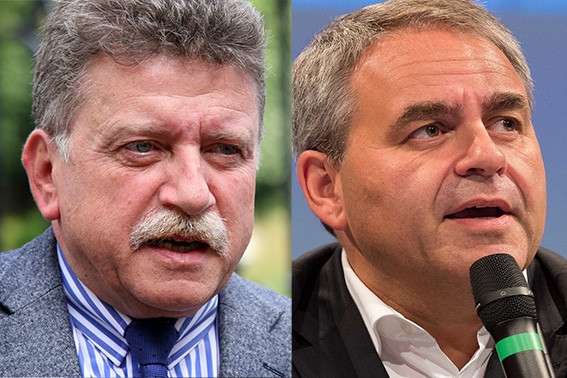
Hauts-de-France: political will driving RNG development
Unprecedented Charter to win public support
Manifesto for RNG as transport fuel
Aim to install 10TWh capacity by 2050
The two leading politicians in the Hauts-de-France region of France have joined forces to advance the development of anaerobic digestion.
In a letter to all inter-municipal (local) authorities the State Prefect Michel Lalande (left) and President of the Regional Council Xavier Bertrand encourage them to promote the regional charter on renewable natural gas (methanization) projects.
The charter aims to create an enabling environment for AD to deliver 100% of the region’s gas needs by 2050, as part of the Hauts-de-France’s strategic goal of ushering in the third industrial revolution, known as Rev3.
Gas is the second most consumed grid energy in France and Hauts-de-France aims to become the lead region for biogas injection – developing the expertise to give it first-mover advantage in RNG delivery as part of the national goal of achieving carbon neutrality by 2050.
In the France Climate Plan, the national government sets out its plans for an energy transition, which emphasises the integral role RNG must play. It is recognised as having by 2050 the potential to exceed the then level of demand for natural gas.
Biogas and the third industrial revolution
Hauts-de-France – meaning Upper France – is a relatively new region, established in 2016 under the Reform of French Regions policy from a merger of Nord-Pas-de-Calais and Picardy.
The region is an industrial and agricultural powerhouse, home to heavy industry – cars, trains and steel – and food production, both for processing and export.
Self-identifying as the cradle of the first and second industrial revolutions in France, centered round its coal mines and spinning industry, and experiencing the adverse impacts of their decline, the region aims to be at the forefront of ushering in the 3rd industrial revolution.
The outlook has been enshrined in the policy known as Rev3, which aims to prepare the region for tomorrow’s industry centered round sustainable development.
“Now everything we make must produce more energy than it uses,” a promotional video for the region declares. In this future, “Nothing is lost, and everything is transformed.”
As part of the energy transition policies contained in Rev 3 anaerobic digestion is identified as having a central role to play in reducing the use of fossil fuels and optimizing the value of waste.
The Charter for RNG development
Under the leadership of Lalande and Bertrand Hauts-de-France has issued a dedicated charter for the development of ‘methanisation projects’.
Entitled “Consultation and Dialogue around Anaerobic Digestion Projects”, it sets out a blueprint for the best way to build support for AD development.
The document recognises that “like many new technologies, methanization is still little known. Its deployment in the rural or peri-urban world, often close to villages, can raise concerns and reluctance”.
The Charter was was launched in 2018 and has been signed by the principle institutional and economic stakeholders in the sector, associated as Metha’Morphose. The primary aim, to spread the word about the benefits of AD.
“For our region, which has a dynamic agriculture sector well served by gas networks, methanization has many advantages,” the organization states, processing biowaste into renewable energies – biomethane, electricity, heat, that replace fossil fuels and thus contributes to the reduction of greenhouse gas emissions responsible for climate change – and digestate that can be used as fertilizer, to support agricultural activities in the territories and diversify farm incomes.
“In short,” it concludes, “a true example of a territorial circular economy.”
To this end the charter delivers a blueprint for opening public consultations at local (municipal) level about the benefits of AD and makes available additional expert support and advice to potential AD developers.
The Charter follows the release of a manifesto for the development of Natural Gas Vehicles and bio-GNV in Hauts-de-France.
Ambitious targets for RNG growth
The region currently has 73 biogas (methanisation) facilities in operation, producing 575 GWh/year. Its development goals are ambitious: to achieve 4.3 TWh by 2030 and 10 TWh in 2050. Employing just 300 today, ADEME – the Environment and Energy Management Agency of France – say between 5-6,000 jobs could be created by 2050 if the 10TWh target is achieved.
A variety of funds are available in support of this, such as FRATRI (Regional Fund for Amplification of the Third Industrial Revolution), which is co-managed with ADEME, to stimulate feasibility studies for the development of the industry, and development of AD for waste management, on-farm and both household food waste and wastes from food manufacturing. ADEME has also explored the technical and economic feasibility of delivering 100% renewable gas in 2050.
This is on top of national tariffs, which range between 6.4 and 9.5 c € / kWh, depending on the size of digester and type of feedstocks. For example, France introduced a tariff rate of €220 per MWh for units below 80kWe with more than 60% animal manure by volume as feedstock. It is nearly three times the rate being offered to domestic waste facilities above 2MWh, €81.2.
Nationally, as of the end of June (2019) 708 biogas units were connected to the electric grid, delivering a total capacity of 470 MW. A further 266 projects are pending, for a cumulative additional capacity of 77 MW.
As of the end of March (2019), the biomethane injection capacity was around 1.36 TWh/year, produced by 88 units. The government’s objective for the sector is to achieve 14-22 TWh/year by 2028. The pending projects amount to an additional 6.15 TWh/year.

